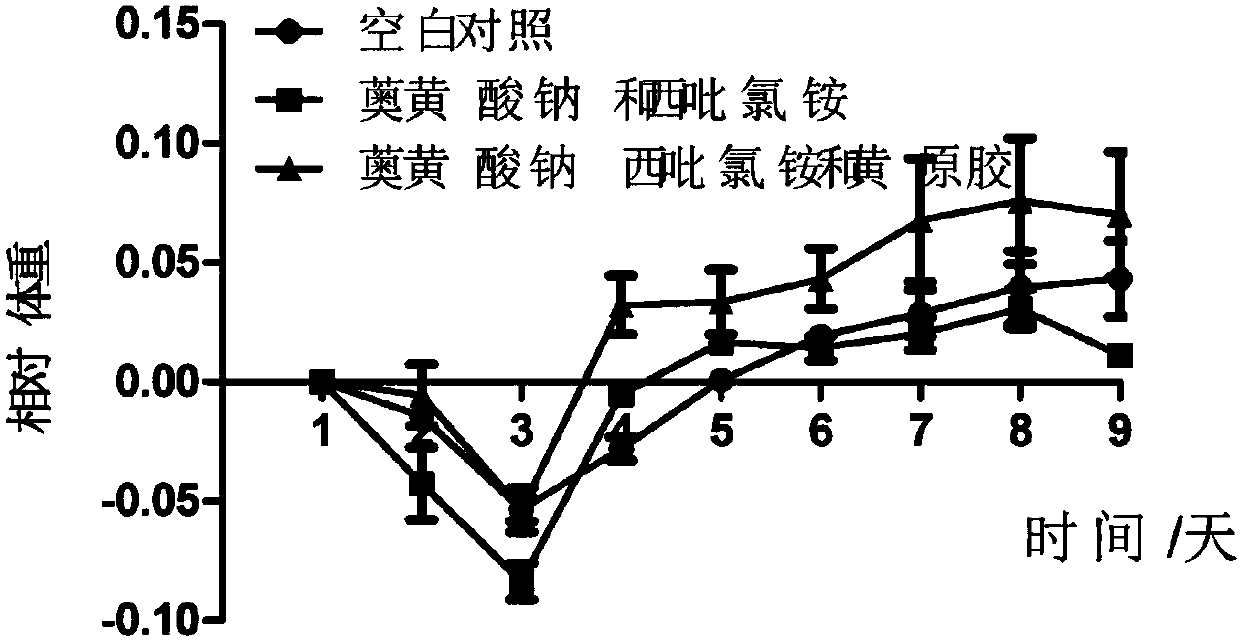Preparation and application of sodium allylsulfonate (SAS) and cetylpyridinium chloride(CPC) compound gel
A technology of cetylpyridinium chloride and sodium azulene, which is applied to medical preparations containing active ingredients, pharmaceutical formulas, active ingredients of anhydride/acid/halide, etc., and can solve the problem of single function, sodium azulene and cetyl Ammonium chloride is unstable, volatile and other problems, to achieve the effect of inhibiting or killing microorganisms, good anti-inflammatory, antibacterial and therapeutic effects, and prevention and treatment of oral ulcers
- Summary
- Abstract
- Description
- Claims
- Application Information
AI Technical Summary
Problems solved by technology
Method used
Image
Examples
Embodiment 1
[0014] Embodiment 1: antibacterial experiment
[0015] Experimental strains: Escherichia coli, Staphylococcus aureus, Lactobacillus acidophilus, Pseudomonas aeruginosa, Candida albicans, Streptococcus mutans, Actinobacillus actinomycetes.
[0016] Strain medium: LB plate, CDC anaerobic blood plate, common blood plate and nutrient broth medium.
[0017] Experimental group preparation: take 0.1g sodium azulene xanthate and dissolve it in 100ml sodium azulene xanthate gargle blank (the blank of azulene xanthate gargle is Blank: non-crystalline sorbitol, sodium benzoate, RH40 hydrogenated castor oil, propylene glycol , spearmint essence, ethanol, purified water), be mixed with 0.1% sodium azulexanate solution, and obtain 0.03% sodium azulexanate by dilution; take 0.2g cetylpyridinium chloride and dissolve it in 100ml sodium azulexanate In the gargle blank, it is configured into 0.2% cetylpyridinium chloride solution, and 0.05% cetylpyridinium chloride solution is obtained by dilu...
Embodiment 2
[0031] An anti-inflammatory and antibacterial compound jelly, the raw materials for making said compound jelly are: 0.03% sodium azulene sulfonate solution and 0.05% cetylpyridinium chloride solution (CPC) (broad-spectrum bactericidal)
Embodiment 3
[0033] An anti-inflammatory and antibacterial compound jelly. The raw materials for making the compound jelly are: 0.03% sodium azulenic acid solution, 0.05% cetylpyridinium chloride solution and a blank sodium azulenic acid periodontal care gel.
[0034] Select 24 ICR male mice (25-30g), use 50% acetic acid (glacial acetic acid) to induce mucosal oral ulcer model, divide into 5 groups randomly (Blank group, CPC+SAS group and CPC+SAS Gel group), each group 8 The mice in each group were marked and numbered 1-8. Observe the behavior of the mice and the situation of eating and drinking water every day, record the daily body weight of the mice and perform data analysis (see appendix figure 1 ). At the same time, observe the wound surface, including the size of the ulcer, redness, swelling, gray pseudomembrane, and exudate, and make a comprehensive score on the wound surface: 0-the initial wound of the model, red and swollen, gray pseudomembrane; 1-wound not converged, gray The p...
PUM
 Login to View More
Login to View More Abstract
Description
Claims
Application Information
 Login to View More
Login to View More - R&D
- Intellectual Property
- Life Sciences
- Materials
- Tech Scout
- Unparalleled Data Quality
- Higher Quality Content
- 60% Fewer Hallucinations
Browse by: Latest US Patents, China's latest patents, Technical Efficacy Thesaurus, Application Domain, Technology Topic, Popular Technical Reports.
© 2025 PatSnap. All rights reserved.Legal|Privacy policy|Modern Slavery Act Transparency Statement|Sitemap|About US| Contact US: help@patsnap.com



